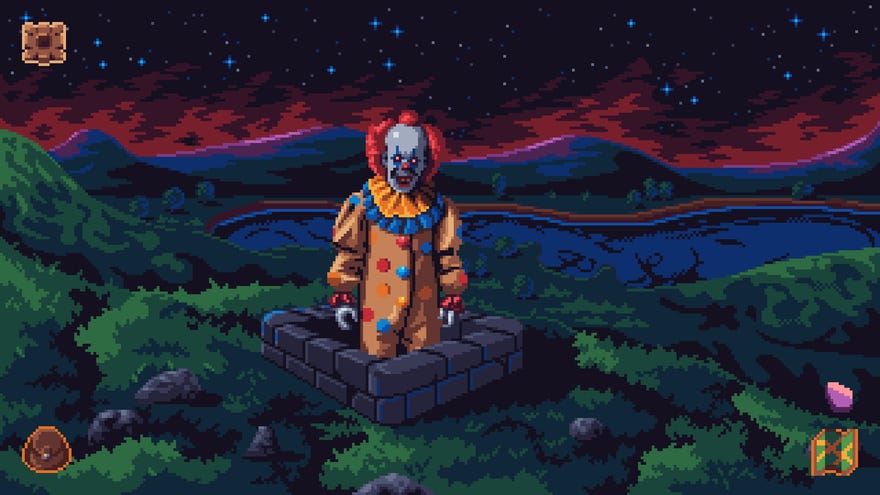Devil's Hideout review: scattershot horror through a surreal urban hell
Like a Stephen King story in its best moments
There's something about mostly empty urban centers in the US that depresses me and disturbs my soul. Whenever I visit family in the States and find myself in a derelict shopping plaza or some other place affected by America's depressing sense of architectural planning and overreliance on cars, I can't help but feel a sense of dread.
Devil's Hideout, a point and click horror game made by indie dev Cosmic Void, takes place in one such abandoned American city, and manages to deliver on this sense of dread even if its eerie hellscape is rough around the edges.
The game casts you as Lauren, who's attempting to rescue her missing sister from cultists. Lauren's journey starts in a hospital, but pretty soon the whole unnamed city turns out to be the titular "Devil's Hideout," and unexplained creepiness starts occurring with great gusto. Skeletal arms pop from walls, corpses hang from fishhooks in a local butchery, and bodies are either pushed from rooftops or appear in mounds with their eyeballs gouged out. Even Pennywise from It - sorry, a clown who just looks and talks like Pennywise - makes a random appearance.
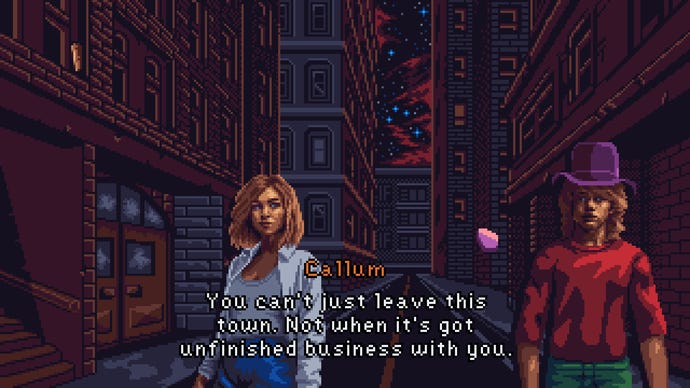
"Random appearance" is an apt phrase to describe a lot of the gimmicks in the game's plot, which is communicated by decent but not spectacular indie voice acting. There are hints that Lauren may have played a deeper role in her sister's disappearance as well as the cult's shenanigans, and I was halfway expecting the city to be a ruined depiction of Lauren's fractured psyche, or some other Silent Hill-esque relevation. We don't get that, as Devil's Hideout is instead content to toss a grab bag of pieces taken from horror media at the player without bothering with much connective tissue. Insert a smidgeon of The Shining here, add a dash of Lovecraft there. Even some of the more unfortunate tropes present in horror films emerge, as (spoiler about a character death incoming) the only obvious person of colour in the game is the first to die.
The aforementioned Pennywise impersonator is a particularly good example of this game's gumbo pot stylings, as he just kinda shows up without explanation to deliver exposition and set up two puzzles. This scattershot presentation of plot threads reminds me of the last Cosmic Void game that I reviewed here on RPS: the Space Quest-style throwback Tachyon Dreams Anthology. That game dabbled with time travel and space comedy in a way that was fine, but didn't always hit the mark in a cohesive manner. Devil's Hideout falls into the same trap, but I will say that this time, it's easier to excuse. This is a horror game, after all, and horror doesn't always need to be explained or tied together. By not doing so, the game felt even more surreal to me, though I'm not sure if all players will be as forgiving.
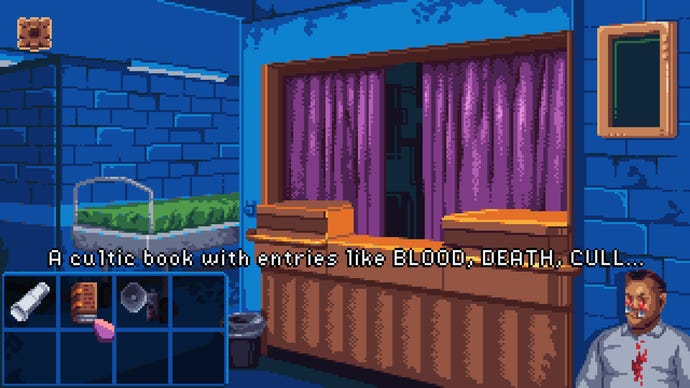
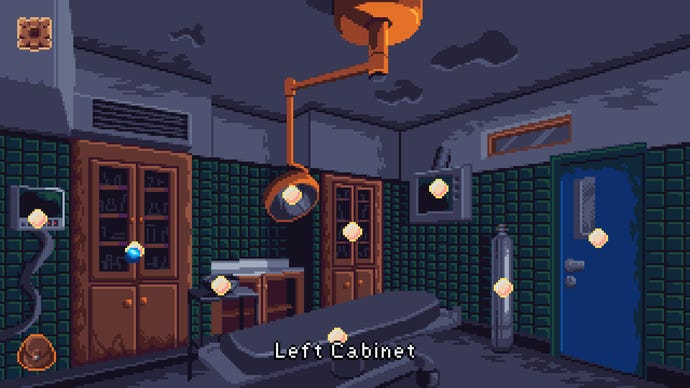
And that surreal nature is augmented by an unusual interface. The game's scenes are presented in a first-person perspective where you've got to click on stuff around the screen to interact with it, not dissimilar to a hidden object game. You can press a button to highlight all interactable objects, which I appreciated, and there's a little inventory section in the left corner. On the rare occasion when Lauren meets a interactable NPC, that NPC shows up in your inventory as an "item" that you can use with other items, which is a neat choice.

I usually prefer a third-person perspective for adventure games, but this setup is effective when Devil's Hideout throws you into darkened screens, illuminated only by the circular glow of Lauren's flashlight. Prepare for a number of jumpscares as creepy manifestations spring out of your flashlight's glow at unexpected intervals, and you should also expect talking heads at the bottom of the screen whenever there's dialogue. You see this in most old school adventure games, but unlike say, King's Quest VI, there's no border around these half-body portraits, and they tend to throw off the perspective of everything else when they appear.
This is especially evident when Lauren's little portrait is juxtaposed against the huge face of an important NPC in the centre of the screen. I'm most reminded of Call of Cthulhu: Shadow of the Comet, a 1993 adventure by Infogrames that feels a lot like Devil's Hideout, from its garish graphical style to the reliance on highly detailed faces plastered over the screen, including ones based on actors' likenesses. (Go search for screenshots of Shadow of the Comet and bask in the talking head who looks suspiciously like Jack Nicholson.)
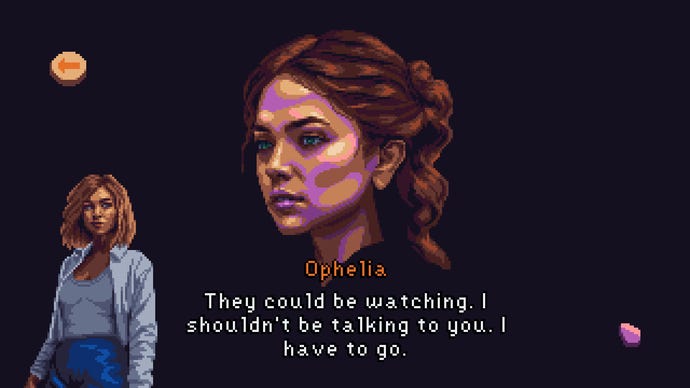
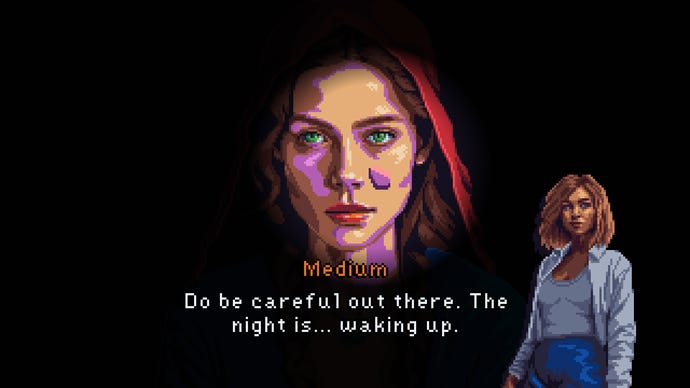
Whether you like the graphical choices that were made or not, there's no denying that the game is expertly drawn. When it comes to the puzzles, though, expect a degree of obfuscation. I'm not saying that anything here is as flabbergasting as Gabriel Knight 3's infamous "use cat fur and maple syrup to create a false mustache" puzzle, but some of 'em come dangerously close. Items appear in unexpected places (why is there a telescope embedded in a corpse's guts?) and you should also get ready to click on as many things as you can until you find the right item combination. Just as there's not much internal logic connecting the horror themes here, there's little logic to the puzzles, alas.

Nevertheless, Devil's Hideout still has a compelling atmosphere that makes me overlook its flaws. In its most evocative moments, it reminded me of a Stephen King story, and I'm not just referring to the Pennywise cameo. A city that's lost all of its wholesome Americana and fallen to evil is simply something that King would write about, though Devil's Hideout would probably be one of those '80s King paperbacks where he was coked up and in need of a better editor. Like Kathy Rain, another point and click that had a lot of random horror stuff happening behind the scenes, I feel like Devil's Hideout could benefit from a director's cut at a later date to help flesh out the bits I liked and hammer down the parts I didn't. There's tremendous potential at play in the alleyways of this urban hell, in other words, and even if it was imperfect, I finished Devil's Hideout wanting more - which is not something I've ever desired from an abandoned American city ever before.
This review is based on a review build of the game provided by the developer.
